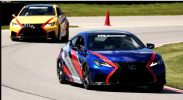Eighteen cylinders of Japanese performance…To celebrate the arrival of the Lexus RC F Track Edition, we drive it back to back with the marque’s legendary LFA supercar

www.carsales.com.au
2019 Lexus RC F Track Edition v 2010 Lexus LFA Feature Comparison
Eighteen cylinders of Japanese performance…To celebrate the arrival of the Lexus RC F Track Edition, we drive it back to back with the marque’s legendary LFA supercar
Models Tested
2019 Lexus RC F Track Edition v 2010 Lexus LFA
Review Type
Comparison
Review Location
Bright, Victoria
Run to the hills
Driving Lexus Australia’s sole LFA ‘ambassador’ on public roads is something of a rarity. I’ve driven some unique and expensive metal in my time, but this takes the cake.
To say I’m a little nervous is an understatement. Ten years have passed since Lexus introduced
the V10-engined LFA supercar and only 10 examples of the then $750,000 carbon-fibre coupe arrived Down Under. They’ve increased in value ever since.
Today a Lexus LFA will set you back close to $1m, and with only 500 produced globally, your chances of haggling are slim. Your chances of driving one back-to-back with the latest track edition V8 street car from Lexus are probably even slimmer.
But what better way to celebrate the arrival of the
Lexus RC F Track Edition Down Under, than to pit it against the car that set the benchmarks for Lexus performance – the LFA.
We asked and Lexus Australia said yes…
Back to the drawing board
Before we get into it, let’s remind ourselves of the LFA’s origins.
Lexus began development of its 4.8-litre V10-powered coupe in February 2000. Initially constructed of aluminium, the LFA was developed from scratch over a five-year period to compete with the best supercars in the world.
The LFA passed all of the company’s stringent reliability and durability tests, made its public debut to resounding applause and then, just weeks before entering production, was scrapped.
The decision no doubt saw millions of development hours and dollars flushed away; but it was one that, in the fullness of time, would create a far superior car.
Learning from its time under the Toyota banner in Formula 1 – and taking heed of rivals that included the Aston Martin DBS, Ferrari F430, Lamborghini Gallardo, Mercedes-McLaren SLR and Porsche Carrera GT – Lexus made the no doubt decision to start development of the LFA over.
The chief engineer at Lexus, Haruhiko Tanahashi, and his team began reworking every square inch of the LFA. The chassis and much of the bodywork were reimagined in carbon-fibre, the interior too.
Lexus pioneered a method of weaving carbon-fibre to create the monocoque for the car – a veritable work of art. In all, 65 per cent of the car is carbon-fibre.
The rest is a mix of exotic metals including aluminium, magnesium and titanium, all with the intention of keeping weight to a minimum. Officially, the Lexus LFA ended up tipping the scales at 1480kg (kerb).
The team then spent a further four years honing and shaving grams from every component. They effectively made a whole new car.
The ‘second’ LFA was 100kg lighter and better balanced than the stillborn Mk1. A decade on, Lexus’ engineers nailed the brief.
Engineering euphoria
No less impressive than the chassis engineering was the glorious Yamaha-tuned 4.8-litre V10 engine.
Lexus built it from scratch, made to service the LFA and the LFA only. And as has become the custom for ‘special’ engines, each of the 500 units produced was autographed by the craftsman who assembled it.
Tanahashi believed only a V10 could create the kind of performance and “euphoric harmonics” supercar drivers desired. In a Yamaha sound studio he trialled countless intake and exhaust designs and sampled weeks of Formula 1 re-runs. Lexus claims it took two years to get the harmonics right.
The narrow-bank (72-degree) V10 was compact, and sounded phenomenal. It also produced outstanding performance for its size.
Free-revving to 9000rpm in 0.6sec, it makes 412kW and 480Nm – the latter not massive compared to today’s turbo V8s but pool-table flat from 3700-9000rpm. It drives the rear wheels via an Aisin-sourced six-speed, single-clutch robotised manual transaxle, and accelerates the LFA to 100km/h in just 3.7sec on its way to a maximum speed of 325km/h.
The LFA revved so quickly Lexus had to make a digital tacho that could keep up. No analogue dial would match its pace, it said.
Pace come naturally to the LFA and on completion it set a Nurburgring Nordschleife lap time of 7:14.640.
It’s pace was enhanced by aerodynamic stability. As with every other element of the LFA formula, Lexus designed the aero package to be as efficient and effective as possible.
Taking cues from the Lexus luxury car line-up, aerodynamicists employed underbody panels to reduce turbulence and improve high-speed stability, while adding tiny bubbles to the mirrors and headlights to micro-manage air flow over the side glass.
There’s a now-common pop-out spoiler to create downforce – and disturb air under braking – and front bumper intakes shaped to not only channel air to the engine, but to also cool the brakes.
The LFA was the first Lexus to use carbon-ceramic brake rotors. They’re huge (390mm front and 360mm rear), spectacular in appearance and capable of stopping the LFA from 113-0km/h (70mph) in just 48m.
Higher learning
When you see the LFA parked alongside its RC F descendant you begin to appreciate the knowledge Lexus has gained in the past 20 years. As ‘regular’ as road-going Lexus models appear, there are cues throughout the F-branded range that recall the LFA.
The RC F Track Edition is THE prime example.
Making its public debut at the Detroit motor show this year (incidentally the same venue as the original LFA in 2005), the RC F Track Edition is designed to challenge the likes of the BMW M4 and Mercedes-AMG C 63 Coupe with what Lexus says is “a serious performance car for the track and the luxury craftsmanship expected of a Lexus”.
Priced from $165,690 (plus on-road costs), the RCF Track Edition boasts changes over the ‘regular’ RC F that Lexus says were inspired by the company’s racing operations in Japanese Super GT and US-based IMSA GT3 racing.
Utilising extensive carbon-fibre componentry, lightweight metals and a free-revving naturally-aspirated V8, the RC F Track Edition bears an undeniable family resemblance.
Even a decade on, there are stylistic elements that recall many of the LFA’s more innovative features. Inside, the instrument panel is a most prominent reminder of where the company’s sporting F brand made its first indelible mark.
The powerplant of the RC F can actually be traced back to the second Lexus ‘F’ model,
the IS F.
In that first iteration the 5.0-litre engine boasted port and direct injection, a two-stage induction system, and fluid cooling systems designed to handle high-g cornering. It developed 311kW at 6600rpm and 503Nm at 5200rpm and drove the rear wheels via an eight-speed automatic for a 0-100km/h time of 4.6sec.
Like the LFA, the IS F’s wonderfully sounding engine was tuned by Yamaha.
The IS F was important not only to Lexus and the development of its F brand, but in understanding the RC F as well. The RC is essentially a two-door coupe version of the latest generation IS sedan, and has commonality that extends beyond the driveline alone.
Look at the chassis, suspension, body styling and interior and the similarities are indisputable.
The more things change…
That high-revving V8 continues to make its presence known at Lexus. In the RC F Track Edition it’s tweaked to make 351kW and 530Nm, the latter arriving at 2800rpm, thanks to revised intake routing and a lower secondary intake trigger point.
Lexus added launch control to the RC F’s eight-speed auto and bolstered the suspension and engine mounts for the Track Edition, also changing the final drive ratio to shorten the 0-100km/h dash to 3.9sec.
There are weight reductions courtesy of increased carbon-fibre panel work (which incidentally is made at the same facility that produced the LFA), hollow rear half-shaft axles, a pared-back intake manifold, smaller air-conditioning compressor and aluminium toe control and upper support brackets.
In all the Track Edition is 80kg lighter than its predecessor.
Like the LFA, the RC F Track Edition places considerable emphasis on aerodynamic efficiency. Newly shaped head and tail-lights, remoulded bumper covers and whisker-like front canards boost downforce and steering response at high speed.
A fixed wing replaces the LFA inspired pop-up spoiler on the regular RC F and adds 26kg extra downforce overall.
Thumb through the catalogue and the lineage of the RC F Track Edition is even more pronounced.
Brembo carbon-ceramic brake rotors and BBS forged alloy wheels join a titanium ‘cat-back’ exhaust and bespoke Michelin Pilot Sport 4S tyres.
Even the mix of interior materials and décor bear an uncanny resemblance to the LFA which, according to Lexus International executive vice president Koji Sato, is no accident.
“The new RC F and the Track Edition, in particular, benefit from constant development since their original launch,” Sato-san told media gathered for the model’s launch earlier this year.
“With the latest improvements, these models help further distinguish the F brand by offering fast, durable, highly capable performance cars that rely on a range of technologies to help make their performance accessible to drivers of all skill levels.”
Skirting the sky in style
One of Australia’s best drives was the venue for our Lexus LFA v Lexus RC F Track Edition head to head. Alas, its name should have been a clue to the weather that awaited us.
Running from Wangaratta in Victoria’s north-east to Bairnsdale in Gippsland, the picturesque Great Alpine Road is one of Australia’s more challenging touring routes.
Winding 303km across the Great Diving Range, the route is Australia’s highest all-season road, rising to a peak of 1804m at the ski resort of Mount Hotham.
It was sealed all the way through at about the same time Lexus began working on the LFA and, given its challenging twists and turns, and brusque changes in elevation, is the perfect match for Lexus’ legendary supercar and its latest progeny.
Unfortunately the weather wasn’t having any part of our plans. Heavy snow saw the road closed to vehicles without tyre chains, meaning an alternate drive across the stunning Tawonga Gap was needed to stretch the F cars’ legs.
Maintaining highway speeds is nearly impossible in the LFA. It begs to be revved. The robotised transaxle too is smoother at higher revs. This adds up to an issue of restraint on public roads and at middling speeds.
The LFA is a better car driven fast; but one that still has its share of ‘surprise and delight’ at an ordinary pace.
It’s a ‘feelsome’ car, to use an odd turn of phrase. You get an immediate understanding of every wheel’s grip – even in the wet, icy weather encountered – and of just how much throttle is required to drive the LFA from corners.
The steering is likewise telepathic. It feels heavy, initially (especially when jumping in and out of the RC F Track Edition) but once ‘dialled in’ to the weight and response, I found it easier to instruct accurately than the RC F. The newer car’s electrically assisted steering was twitchy yet at the same time slower in response from centre.
But perhaps the LFA’s biggest revelation is just how compliant it is. Despite the low ride height and tenacious mid-corner grip, it’s a car that deals unflinchingly with pockmarks and imperfections in the road.
It feels like a track car, yet rides like a well-tuned road car. It’s nowhere near as stiff as its stance suggests, and though I wouldn’t say it’s comfortable, the LFA is a lot more forgiving that I’d expected.
It is a car that commands respect all the same. Indeed, the LFA is still the type of machine that could dole-out a world of hurt in untrained hands. Above 5000rpm the revs build quickly, defying the fat 305-section rear rubber to break its hold on rain-soaked asphalt.
Feed it on gradually and the LFA rewards with a striking turn of speed.
On our drive the tree-lined bends of the Tawonga Gap road approach more quickly with each prod of the loud pedal, the shriek of that wonderful V10 providing a soundtrack strikingly reminiscent of BMW’s P82 Grand Prix engine.
There’s really no describing how emotive the LFA’s dialogue is. It’s not loud, but still manages to carry for miles across the twists and turns of our favourite mountain roads.
It’s simultaneously rich and metallic, the draw of air through the throttle body as intoxicating as the meticulous firing of the oversquare shriek from the V10.
An inspired drive
Driving
the RC F Track Edition after the LFA brings a wonderful contrast to our Alpine experience.
As good as the RC F is in isolation (and it is a huge step forward from previous sporting Lexus offerings), it’s a totally different animal to its forebear on challenging roads like these.
The seat feels higher, the controls are lighter and the finish decidedly more ‘2019’. The LFA doesn’t feel outdated until you sit in the RC F.
The tech levels show how rapidly Lexus has moved on in the past decade. There’s inspiration – and a little commonality – of course; the instrument panel and Touch Pad interface are familiar features in both the Lexus coupes. But the aesthetics and styling cues feel almost futuristic by comparison.
It’s not just the appearance though. There’s a juxtaposition through the driveline and chassis that speaks as much of the differences between the Lexus LFA and Lexus RC F Track Edition as it does their similarities.
Yet, the family resemblance is there once you tune-out the static. Focus on engine response and chassis communication and the LFA bloodline is obvious.
In the LFA, Lexus learned how to make a car talk to its driver, and respond not only with immediacy, but accuracy as well. The RC F Track Edition might be a little heavy when viewed against the carbon-fibre LFA, but it’s as sharp a tool as we’ve yet seen from Lexus.
That constant improvement of the company’s Lexus’ F line and F Sport models highlights the capability of a marque we often write-off as a “more expensive Toyota”. In the LFA, Lexus produced a car of world-beating quality and performance – and that pedigree exists in the RC F.
It also brings hope that the brand’s love of performance isn’t dead. The LFA may never return, but its spirit – and even its DNA – clearly lives on in its descendants. Let’s hope there’s more to come.
2010 Lexus LFA pricing and specifications:
Price: $750,000 (when new, plus on-road costs)
Engine: 4.8-litre ten-cylinder petrol
Output: 412kW/480Nm
Transmission: Six-speed robotised manual
Fuel: 16.7L/100km
CO2: 270g/km
Safety rating: N/A
2019 Lexus RC F Track Edition pricing and specifications:
Price: $165,690 (plus on-road costs)
Engine: 5.0-litre eight-cylinder petrol
Output: 351kW/530Nm
Transmission: Eight-speed automatic
Fuel: 10.9L/100km
CO2: 253g/km
Safety rating: N/A

 www.timeattack.co.jp
www.timeattack.co.jp


















